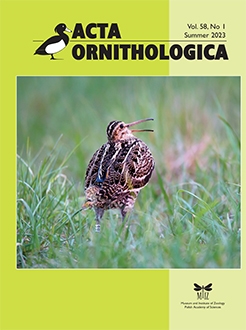 |
| https://bioone.org/journals/acta-ornithologica/volume-58/issue-1/00016454AO2023.58.1.003/Differential-Flight-Strategies-of-Western-Marsh-Harrier-Circus-aeruginosus-in/10.3161/00016454AO2023.58.1.003.short |
Differential flight strategies of Western Marsh Harrier Circus aeruginosus in relation to sex and age class during spring migration in the Central Mediterranean
Nicolantonio Agostini, Marco Gustin, Michele Cento, Jost von Hardenberg, Gianpasquale Chiatante
Acta Ornithologica 58: 41-53.
Several bird species show differential migration in relation to age and/or sex classes, often associated with morphological and behavioural differences. The Western Marsh Harrier Circus aeruginosus is a partial migrant, showing a strong sexual dimorphism in size. This species migrates on a broad front, undertaking long water crossings through the Mediterranean Sea. In this study we carried out a two-year survey on the pre-breeding migration of this species at three sites located in the Central Mediterranean region: the islands of Ustica and Panarea (Tyrrhenian Sea) and the Strait of Messina (Peloritani Mountains). The aim of this study was to analyse the flight strategies of this broad front migrant in relation to wind patterns, such as in relation to different sex and age classes. Our results revealed differential flight behaviours among harriers belonging to different sex classes, with adult females less attracted to islands than adult males during a sea crossing, and adult males reaching higher altitude early in the season along a mountain chain. It is suggested that adult males, thanks to their smaller size, use to a larger extent soaring flight by exploiting even weak thermals en route. Unlike the Tyrrhenian islands, few immatures were seen passing along the Peloritani Mountains, probably because they fly at lower altitudes over mainland, passing over areas where they can eventually find prey and/or rest at stop-over site en route. In conclusion, our study shows that the location of the observation post can affect the result concerning migration survey of both sex and age classes in this species, leading to evident bias.
NUOVO ARTICOLO SULLA MIGRAZIONE DEL FALCO DI PALUDE PUBBLICATO SU ACTA ORNITHOLOGICA
Numerose specie di uccelli mostrano migrazioni differenziali in relazione alle classi di età e/o sesso, spesso associate a differenze morfologiche e comportamentali. Il Falco di palude Circus aeruginosus è un migratore parziale, che mostra un forte dimorfismo sessuale nelle dimensioni. Questa specie migra su un ampio fronte, intraprendendo lunghe traversate attraverso il Mar Mediterraneo. In questo studio abbiamo condotto un'indagine sulla migrazione primaverile di questa specie in tre siti situati nella regione del Mediterraneo centrale: le isole di Ustica e Panarea e lo Stretto di Messina (Monti Peloritani). Lo scopo di questo studio era quello di analizzare le strategie di volo di questo migratore su fronte ampio in relazione alle diverse classi di sesso e di età. I nostri risultati hanno rivelato differenti strategie migratorie adottate da individui appartenenti alle diverse classi di sesso, con le femmine adulte meno attratte dalle isole rispetto ai maschi adulti durante la traversata del Mar Tirreno, e i maschi adulti che guadagnano quote più elevate all’inizio della stagione lungo una catena montuosa. Si ipotizza che i maschi adulti, grazie al loro minor peso, utilizzino in misura maggiore il volo veleggiato sfruttando anche le termiche più deboli. Pochi immaturi sono stati visti transitare lungo i Monti Peloritani, probabilmente perché essi tendono a volare a quote più basse sulla terraferma, passando su aree dove possono eventualmente trovare prede e/o riposarsi. In conclusione, il nostro studio mostra che l’ubicazione del posto di osservazione può influenzare il risultato relativo al monitoraggio del passaggio di individui appartenenti a differenti classi di età e sesso in questa specie, portando ad evidenti distorsioni.